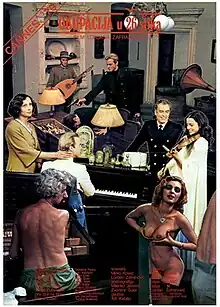Occupation in 26 Pictures
Occupation in 26 Pictures (Serbo-Croatian: Okupacija u 26 slika; also distributed internationally as Occupation in 26 Tableaux) is a 1978 Yugoslav war film directed by Lordan Zafranović.The film was selected as the Yugoslav entry for the Best Foreign Language Film at the 51st Academy Awards, but was not accepted as a nominee.[1]
| Occupation in 26 Pictures | |
|---|---|
 | |
| Directed by | Lordan Zafranović |
| Written by | Lordan Zafranović Mirko Kovač |
| Starring | Frano Lasić Boris Kralj Milan Štrljić Stevo Žigon Zvonimir Lepetić Bert Sotlar Boris Dvornik Dušica Žegerac Izet Hajdarhodžić Antun Nalis Zlatko Vranjican Gordana Pavlov |
| Cinematography | Karpo Ačimović Godina |
| Edited by | Josip Remenar |
| Music by | Alfi Kabiljo |
Production companies | Jadran film Croatia film |
Release date |
|
Running time | 116 minutes |
| Country | Yugoslavia |
| Language | Serbo-Croatian |
Plot
The film is set in Dubrovnik, the last few days before the Second World War. The story revolves around three friends — Miho (a Jew), Niko (a Croat) and Toni (an Italian). They spend their days in each other's company - they're shown visiting a prostitute named Pina together, and later during practice at a fencing club. Toni is in a relationship with Niko's sister Ana, who intends to marry him. The engagement is interrupted by the noise of fighter jets and gunfire. Fascist and Nazi soldiers enter the city and occupy the entire area. Subsequently, Dubrovnik is annexed by the NDH and brought under a brutal dictatorship by the Ustashe, which divides the locals: Toni becomes a fascist, Miho is kicked out of his fencing club, while Niko and his father Baldo become anti-fascists and join the communist resistance.
At a fascist celebration, Niko turnes a picture of Mussolini upside down. By that point, Toni is a staunch anti-communist. In one raid, the Ustashe round up a dozen dissidents, mostly Jews and one Orthodox priest who preached in Russian, and take them by bus out of the city into the wilderness, slaughtering them. The bus driver, a Croat, calls the fascists freaks, whereupon they kill him too. Miho's father is also killed on the bus, and Miho, while the Ustashe are distracted by the bloodbath, jumps off the bus. Ana gets pregnant and marries Toni. Baldo is arrested for publicly expressing his contempt for the fascist movement, and dies in an attempt to escape deportation to a concentration camp. Toni moves into Niko's house, claiming that it is now his. Toni is about to leave the house together with Miho, who is hiding at his place. The three of them sing the song Drugovi stari (Old friends) for the last time. In the middle of the song, Niko shoots Toni. Ana enters and is shocked by the sight. Niko and Miho pack up and leave, joining the partisan movement.
Cast
- Frano Lasić as Niko
- Milan Štrljić as Toni
- Tanja Poberžnik as Ana
- Boris Kralj as Baldo
- Ivan Klemenc as Miho
- Gordana Pavlov as Mara
- Stevo Žigon as Hubička
- Bert Sotlar as Stijepo
- Marija Kohn as Luce
- Karlo Bulić as Paško
- Zvonko Lepetić as Gavran
- Milan Erak as Maraš
- Antun Nalis as Paolo
- Tanja Bošković as Pina
- Izet Hajdarhodžić as Dum Đivo
Controversies
The film was controversial due to many things. In Yugoslavia it was perceived as scandalous because of too many sexually explicit and violent scenes.[2] Naturalistic portrayal of the widespread Ustashe atrocities made this film despised in independent Croatia.[2]
Critique
Although generally praised, the film caused very mixed reactions from critics. Croatian film critic Nenad Polimac once called it trash, which is why he was blacklisted in the Croatian newsletter Polet (for a while he was neutralized as an associate, as they did not want to publish his articles and prevented him from appearing on radio and television).
Critic Damir Radić wrote for Filmski Leksikon:
"With a stylistically refined expression, Lordan Zafranović shapes his constant theme of individual and collective evil, focusing this time on the repression of Croatian and Italian fascists, staged in a naturalistic-grotesque key, with a climax in the famous sequence of the massacre in the bus. The grotesque-carnival approach is also evident in the treatment of sexuality, and is contrasted with the graceful physicality of the protagonist. The intriguingly announced elaboration of the characters and their relationships (especially the erotic triangle with incestuous implications of Niko - Anna - Toni, and the class-gender turn in the relationship between Niko - Mara) remains unfulfilled, and the ambitious attempt to portray a comprehensive social frescoes with patriotic citizens in the foreground (a thematic innovation in Yugoslav film at the time) only partially succeeded. Narrative-dramaturgically confused, stylistically and atmospherically impressive, the film caused great aesthetic-political controversies."[3]
Awards
- Nomination for the Palme d'Or in Cannes.[4]
- Won 3 awards at the Feature Film Festival in Pula (best film, director and cinematographer).[5]
See also
References
- Margaret Herrick Library, Academy of Motion Picture Arts and Sciences
- A booklet with the film, Jutarnji list 2012, ISBN 978-953-7770-73-0
- "Filmski leksikon". film.lzmk.hr (in Croatian). Retrieved 26 September 2023.
- "Festival de Cannes: Occupation in 26 Pictures". festival-cannes.com. Retrieved 24 May 2009.
- "HRVATSKE MANJINSKE KOPRODUKCIJE – Pula Film Festival". pulafilmfestival.hr (in Croatian). Retrieved 26 September 2023.